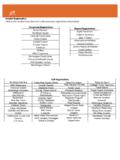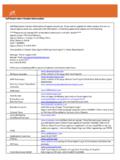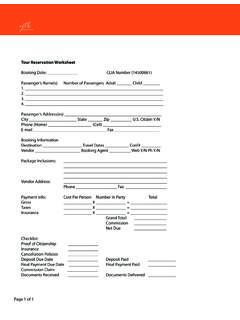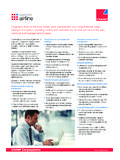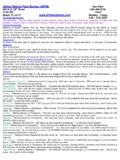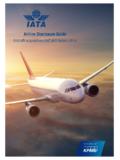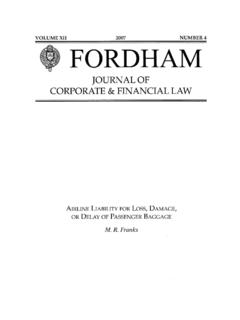Transcription of Types of Airfares - Rules and Regulations for …
1 Types of Airfares - Rules and Regulations for Airline Tickets 1. What is a Fare? Airfares are most often based on one-way or round-trip travel. Fares may be published, unpublished and/or negotiated fares (corporations, or government agencies/organizations may have fares negotiated with an airline at a lower rate). Unpublished fares are also known as consolidated fares and are offered by consolidators or bucket shops. 2. Published Fares: A published fare is one that is available for purchase by anyone. An unpublished fare works a bit differently. 3. The ABC s of Airfares When booking a ticket, regardless of whether it is using a published or unpublished fare, there are letters that are assigned to different fares. These letters indicate the class of service, not simply indicating economy or business class, but rather the type of fare that was purchased.
2 4. Types of Published Airfares Explanations for the different Types of Airfares such as APEX and full fares. You don't always know what you are going to get when you purchase an airline ticket. Why is it that every person on a flight may have paid a different price to fly? Can you change or cancel your tickets, and if so, at what cost? The airlines have a seemingly secretive formula for constructing Airfares . Knowing what Types of Airfares exist, and how they apply to your travel may not mean that Airfares make sense, but you can at least make sense of them. Simply put, an airfare is the price a passenger pays in order to travel by air. The Types of fares, Rules and restrictions, taxes, etc., are all components that complicate the price involved for a passenger to fly from one place to another. Fares are most often based on one-way or round-trip travel.
3 Fares may be published, unpublished and/or negotiated fares (corporations, or government agencies/organizations may have fares negotiated with an airline at a lower rate). Unpublished fares are also known as consolidated fares. The following is a list of the main Types of published Airfares - and are based on round-trip or one-way travel: APEX fares are discounted international fares. Such fares usually require tickets to be purchased in advance (such as 7, 14, or 21 day minimum advance purchase), and will have other restrictions - non-refundable, change fees are just a few of the possible restrictions. Discount Fares are fares that tend to have a smaller price tag, and are offered for a limited time (seat sales would fall into this category). They usually have a long list of restrictions such as specific travel dates, minimum and maximum stay (for example, a minimum Saturday night stay, a maximum 30 day stay), etc.
4 Unlike most published fares, it is important to make sure that you are aware of the fare Rules and restrictions on discount (seat sale) fares. Keep a copy of the Rules because seat sale fares come and go quickly, and the Rules and restrictions can be harder (sometimes impossible) to retrieve online. Excursion fares are lower priced fares that involve restrictions like advance purchase, time of year, minimum/maximum stay, etc. Unrestricted, Flexible, or Full Fares are the titles given to the most expensive tickets. You pay for a ticket that allows you to refund or change the ticket as necessary for fares that can be purchased at any time, even the same day of travel. Joint Fares are offered by airlines that have some sort of partner relationship on select routes. They essentially give a passenger a price break when you are using more than one airline to get somewhere.
5 Joint fares have their own set of restrictions, not unlike those already mentioned for excursion and discount fares. A through fare is a fare to a destination reached by traveling through a gateway city. It could be combined with any of the fare Types listed above, and is used to obtain a lower price when you are not simply flying from point A to point B, but are rather connecting through other points to get to your destination. If you are traveling from Atlanta to Athens via Frankfurt, you may be offered a through fare, so that instead of paying for Atlanta to Frankfurt and Frankfurt to Athens, you pay one fare for Atlanta through to Athens. For the sake of profits, airlines will not offer every seat on an aircraft at the seat sale fares, or excursion fares. As flights fill, the least expensive fares disappear regardless of how far in advance it is.
6 Unless you are on a full fare ticket you can be certain that there will be any number of restrictions involved with your airfare - minimum/maximum stay; time of day; weekday, weekend price differences; change fees; mileage (on through fares you may be restricted to a certain number of miles to get you to your destination), advance purchase; youth/child/senior rule differences; So many fare Types , even more fare Rules . Considering that airline tickets are contracts between passengers and airlines it is important to know what you are looking for. A published fare is one that is available for purchase by anyone. You could call the airline, or check for prices online, and published fares will be immediately available for purchase The Rules of such fares are readily available and if there is more than one airline offering the same fare you can count on the Rules being virtually the same.
7 A non-refundable fare requiring an advance purchase of 14 days and a minimum Saturday night stay would be just a few of the possible Rules of a published fare. Seat sales launched by airlines are considered published fares as well since (subject to seat availability) such Airfares are offered to the public. Unpublished fares are an entirely different beast. They may be seats that a consolidator purchased and can offer at highly discounted rates. The fare Rules could literally contain anything from absolutely no changes allowed to free changes as long as availability exists. They may or may not allow for advance seat selection or the accumulation of frequent flyer miles. If you called an airline looking for the Rules to an unpublished fare you would be out of luck. They are not offered for sale by the airline online or over the phone with the airline.
8 When booking a ticket, regardless of whether it is using a published or unpublished fare, there are letters that are assigned to different fares. These letters indicate the class of service, not simply indicating economy or business class, but rather the type of fare that was purchased. Without getting into the particular Rules of each fare type, letters are assigned by the airlines to indicate the kind of ticket that has been purchased. F, P are the letters most commonly used to indicate First Class. J, C are the letters most often used to represent Business, or Executive Class. Y is almost universally used to indicate a full fare economy ticket. B, H, L, M, V, etc. are just some of the letters indicating subclasses (reduced, restricted, and/or discounted fares). These letters vary by airline and in value. On one airline B may be indicative of a more expensive ticket.
9 On another airline L may represent a ticket booked on a seat sale. X, U, R are a few of the letters commonly used to indicate a fare purchased from a consolidator. If you have booked a discounted fare and are interested in the subclass you are holding, the letter immediately follows the flight number on your ticket and will fall under the heading of Booking Class or some similar, shortened version. In times of emergency when you have to fly for a family funeral, or to see a terminally ill relative, shopping around for Airfares is probably the last thing you want to think about. Many airlines have an answer for this - the bereavement fare, or compassionate fare, which is offered to family members traveling for a death in the family, or imminent death. So what should one know about bereavement fares? They are not always the lowest fare, but are last minute fares that can be booked right up until departure time.
10 They are offered for family members traveling to a funeral. They can also be offered for family members in the case of imminent death, where a family member is gravely ill. Bereavement fares usually entail a discount off of a full fare (unrestricted fare), and are often more expensive than the cost you would pay for a seat sale ticket. Bereavement fares tend to be very flexible, permitting free changes and stays of up to 30 days with no minimum stay requirements. You can usually secure the discount prior to travel if you provide the required information. A few airlines will only refund the value of the discount after travel is completed. However, all airlines that offer bereavement fares will allow you to apply for a refund after travel is completed (usually you must apply for a refund within 90 days after completion of all flights, along with the required documentation).
